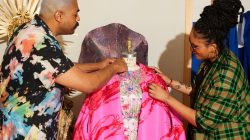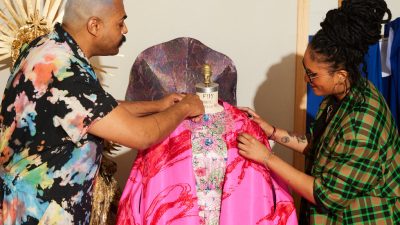In 2022, when Mark Ronson, the Grammy- and Oscar-winning D.J., songwriter and super-producer, became a brand ambassador for the Swiss watchmaker Audemars Piguet (A.P.), there was an element of kismet to the partnership.
“I know about A.P. through music,” Mr. Ronson recalled last month on a phone call from his home in New York City. “I probably heard the name Audemars Piguet out loud, for the first time, with the correct pronunciation, in a Jay-Z song.”
Then, about 15 years ago, Mr. Ronson glimpsed a 1980s gold Royal Oak, the watchmaker’s flagship model, on the wrist of “somebody in a cool bar in Paris,” where he was hanging out with the French electronic duo Daft Punk. “I had to track it down,” he said.
In July, the multi-hyphenate entertainer hit a high note in his relationship with the brand when, wearing a 1982 gold Royal Oak from his personal collection, he performed at a closing-night concert that he had curated on A.P.’s behalf at the Montreux Jazz Festival in Switzerland. Since 2019, the watchmaker has been a global partner of the event, set on the shores of Lake Geneva, but its involvement with the festival dates to 2010, when it began supporting the digitization of the event’s vast sound archives.
Over the past five years or so, a growing number of watchmakers, eager to grow their own reputations in the music scene and amplify their connections with younger consumers, have followed the watch brand’s lead — directly into the recording studio. Seduced by the cool factor of working with top musical talent, as well as the social media hype such partnerships tend to generate, luxury brands are now focusing their resources on cultural tastemakers with enough sway to convince new audiences to consider mechanical timepieces.
In 2021, for example, Hublot introduced an edition of the Big Bang, its signature timepiece, encased in iridescent titanium and created in collaboration with the French music producer DJ Snake (real name: William Sami Étienne Grigahcine). Three years earlier, Hublot invited the D.J. to preside over the decks at the closing party for the FIFA World Cup in Russia. (The brand has served as the World Cup’s official timekeeper since 2010.)
“Music is so powerful — it always brings people together,” Ricardo Guadalupe, Hublot’s chief executive, wrote in an email. “By partnering with a talented artist like DJ Snake, we also speak to a whole community that is passionate about music and having a good time. It’s a lifestyle that we are genuinely connected to.”
Luxury brands still partner with classical pianists, world-class symphonies or the legends of opera — Rolex, for example, has relationships that include the conductor Gustavo Dudamel and the pianist Yuja Wang. But prestige brands are also looking to performers of contemporary music, from hip-hop to electronic dance music.
“Nowadays, we associate dance music with luxury settings: Mykonos, Ibiza, Lisbon,” Nikita Choraria, creative director of the London-based watch customizer Pro Hunter and a self-described “house girl,” said in a recent phone call from Portugal’s capital city, where she was on vacation.
That helps explain why, in early July, Pro Hunter introduced its fifth collaboration: a customized Rolex Submariner with a matte black DLC (diamond-like carbon) coating, made for the Dutch record label Armada Music.
Armada, founded in 2003 by the D.J. Armin van Buuren and his business partners Maykel Piron and David Lewis, had been looking for a way to mark its 20th anniversary. The watch, limited to 10 pieces, eight of which sold before its release, features accent details in the label’s signature blue as well as its logo on the sweeping seconds hand.
Ms. Choraria explained the partnership — which came about because Mr. Piron, a watch collector and client of Pro Hunter, saw a collaborative model that the company had made with the Dutch jeans brand Denham — as a reflection of the changing face of luxury.
“Our demographic used to be my father’s generation, and now I see so many young people coming to us for watches,” Ms. Choraria said. “The crypto lottery winners, a huge bunch of tech people and women. There’s been a massive shift in the demographic of luxury.
“At the same time, Louis Vuitton started collaborating with rappers and skater brands,” she added. “It’s also when collaborations started becoming more popular with uber-luxury brands and trendy eclectic brands, all aiming for a younger market.”
Audemars Piguet was ahead of the pack. Led by François-Henry Bennahmias, its brash chief executive, the brand began cultivating friendships within the hip-hop scene more than 20 years ago, when Mr. Bennahmias was still the managing director of its North American division. (About a year ago, he announced that, after a decade as chief executive, he would leave the company at the end of 2023.).
“I got the chance to meet Jay-Z in 2001 through a common friend, and we connected immediately,” Mr. Bennahmias said in a recent voice memo he provided in response to questions. “I saw that hip-hop could become what jazz was in the ’20s. It started in the African American world and became mainstream.”
In 2005, long before luxury collaborations became ubiquitous, the watch brand introduced the Royal Oak Offshore Jay-Z 10th Anniversary Limited Edition. Codesigned with the hip-hop mogul to mark his decade in the music industry, the model was marketed in an edition of 100 pieces, including 20 in platinum, at $69,500. Each watch came with a specially engraved Apple iPod loaded with Jay-Z’s albums.
In 2010, the brand introduced another collaborative model, this time with the megaproducer Quincy Jones.
A new model, introduced in early July, bolstered Audemars Piguet’s commitment to what Mr. Bennahmias called “music as a whole.” The Royal Oak Offshore Music Edition is a black ceramic 37-millimeter version of a 2022 timepiece featuring a dial with a multicolor mosaic that looks like an equalizer, knurled-texture studs reminiscent of jack plugs and crown guards inspired by the audio faders on mixing consoles.
In recent years, more watchmakers have sought to capitalize on hip-hop’s cultural cachet.
In 2019, Richard Mille solidified its friendship with the rapper, songwriter and music producer (and now Louis Vuitton men’s creative director) Pharrell Williams, a longtime fan of its watches, with the RM 52-05 Tourbillon Pharrell Williams. The $969,000 limited edition piece features an imaginary landscape of Mars and a view of Earth, both rendered in enamel, within the outline of an astronaut’s helmet in titanium.
In an email, a spokeswoman for Richard Mille said timepieces designed with and for musicians were inherently different from those designed for athletes (such as Rafael Nadal). For example, she said, the size, weight and ergonomic constraints of the RM 52-05’s astronaut helmet design would rule it out for a sports model.
A quote from Mr. Williams on Richard Mille’s website sheds further light on the synergies between watchmaking and music: “What Richard does is build something that lets you take the metric of what time looks like. That’s a wizard-level art form. I’m a producer, I know how to stand next to the guy, even in this instant: Richard is the guy. I know baselines and chords and harmonies. That’s it. I’m harmonizing with him.”
Zenith, too, recognized the value of an association with contemporary music. In 2020, the brand named the British house and techno D.J. Carl Cox as a global friend of the brand.
“We met in London in a restaurant in 2019,” Julien Tornare, the brand’s chief executive, recalled. “The idea was to get someone from the music world. We weren’t sure if we wanted to go for a singer or a musician or a D.J. It’s really about the personality.
“Carl shared with me the story of his life,” Mr. Tornare added. “He wasn’t coming from a particularly wealthy family and had to work very hard to reach his dreams, and for me, it’s very much about that story, about the journey.
“We’re not looking for the red-carpet effect; we’re really looking for authenticity — someone who can stand onstage and share his dreams.”
In early 2020, Zenith introduced the Defy 21 Carl Cox, a $19,700 limited-edition chronograph with a rotating disk shaped like a vinyl record at 9 o’clock to indicate the running seconds as well as a glow-in-the-dark carbon bezel and strap stitching. Later that year, when lockdowns were in full effect in many places, Mr. Tornare and Mr. Cox engineered a perk for people who had bought the watch: a private D.J. set on Instagram Live.
“It was Covid; we were stuck behind our screens in Zoomland,” Mr. Tornare recalled. “He was super accessible and created a special playlist for watch owners.”
For Mr. Cox, a longtime watch lover, the opportunity to tie together his passions for music and watchmaking was the hook.
“That’s what was really exciting,” Mr. Cox said in a recent call from Sardinia, where his eponymous automotive racing team was participating in an Extreme E championship. “Having a watch associated with my own efforts, my own history.”
The 200 timepieces sold out, prompting a follow-up Defy model scheduled for release later this year. “There will be a surprise for the owners, a way to get in touch with Carl,” Mr. Tornare said. “And it has some elements of his favorite D.J. set.”
In March, Zenith gave music fans another reason to pay attention to its watches when it announced its newest friend of the brand, the Italian D.J. and content creator Tudor Laurini, better known as Klaus.
“He’s helping us with the cool factor in Italy, where our audience is a bit conservative,” Mr. Tornare said. “Whereas Carl is known worldwide, Klaus is more tactical in Italy.”
And therein lies the point. Music and watchmaking mash-ups that yield best-selling watches are all well and good, but brands that venture into the D.J. booth are after a lot more than basic transactions.
“The question is not: How do we sell 100 to 200 pieces in a year?” Mr. Tornare said. “The question is: How much buzz can we get?”
Sumber: www.nytimes.com










